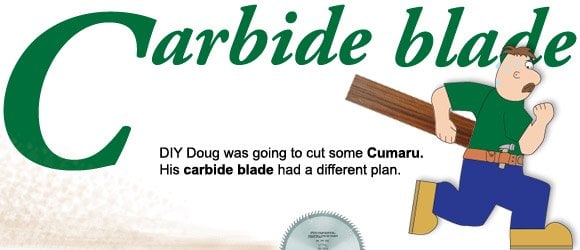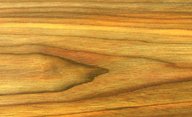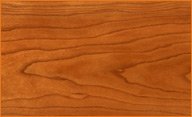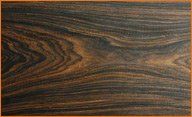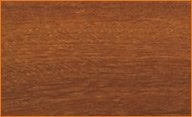| Lumber Glossary Term |
Definition |
| C&F |
Cost and Freight |
| Caliper |
Instrument for determining log and tree diameters by
measuring their rectangular projection on a straight graduated rule via
two arms, one of them sliding along at right angles to the rule itself.
The optical caliper determines upper, out-of-reach diameters through an
optical system incorporating two parallel lines of sight separated by a
variable baseline. |
| Cambium |
The live, actively growing layer of a tree. The cambium is
one cell thick and resides between the phloem and sapwood. It repeatedly
divides itself to form new wood which causes the tree to expand and
grow. It is the layer that becomes either bark or wood and lays dormant
during winter. |
| Canadian Standards Association (CSA) |
A non-profit organization that has developed over 2,000 different standards for a variety of industries. |
| Canary |
- Heartwood varies from pale-yellow-brown to pale olive-brown streaks
- Usually straight and regular grain
- Medium density
- Used for pattern making, musical instruments, cabinets, interior trim for boats, toys and doors
|
| Canopy |
A continuous cover of branches and foliage formed collectively by adjacent tree crowns. |
| Cantilever |
The allowable overhang past the joists or rim joists. |
| Cant |
A log that has been debarked and sawn square. |
| Cap Rail |
The top horizontal piece of a railing placed to give it a finished appearance. |
| Carcase |
The body of a piece of furniture with a box like shape. |
| Carbide Tipped |
Extremely hard steel pieces with sharp cutting edges
fastened to cutting tools such as saw blades, and router bits. |
| Carload |
A railroad car loaded to meet railed minimum weight
requirements for carload rates. The volume in a carload may vary,
depending upon the type of lumber loaded and the size of the car. |
| Card Scraper |
A flat blade with a burred edge used for smoothing. |
| Carpenter’s Pencil |
Rectangular shaped pencil, about 1/4”x ½”, with a 1/16” x 3/16” lead. |
| Carriage Bolt |
A bolt with a rounded head that is pulled down onto the
surface of the wood as the nut is tightened. It's used to hold structural
members together, as the rounded head gives a finished look to the bolt.
Bolts should be checked annually and tightened when necessary. |
| Case Hardening |
A defect in lumber caused when a board is dried too
fast, or improperly. The outer layers in a case hardened board are
compressed while the inner layers are in tension. |
| Casing |
Usually run to pattern and is widely used for interior trim. |
| Cat’s Paw |
A person used by another as a dupe or a tool. |
| Catalyst |
A substance that initiates or changes the rate of chemical reaction but is not consumed or changed by the reaction. |
| Caul Veneering |
A method where the veneers are cut square, taped
together and laid as a single sheet without preliminary dampening. |
| Caulking Seam |
A machined groove or depression worked in the wood.
It provides a weather resistant joint when filled with caulking material
and fitted with an adjoining piece. |
| CB |
Center Beaded |
| Cedar |
Any spreading evergreen conifer of the genus Cedrus bears tufts
of small cones and needles. In full cedar wood, the fragrant durable
wood of any cedar tree. Cedar lumber provides one of the best choices
for deck construction, although more expensive than the cheaper options,
it will last much longer because of its natural decay resistant and
insect repellant properties. |
| Ceiling |
A lumber pattern featuring a center and edge V and/or bead. |
| Cell |
The smallest, microscopic structure in wood. |
| Cellulose |
The carbohydrate that is the principal constituent of wood and forms the framework of the wood cells. |
| Cement |
A powder that serves as a binding element in concrete and mortar. Also, it is an adhesive. |
| Center Beaded |
A patterned lumber shaped to form a narrow half-circle along the center of its length. |
| Center Match (CM) |
Lumber that has been worked with a tongue exactly
in the center on one edge of each piece and a groove on the opposite
edge to provide a close tongue-and-groove joint by fitting two pieces
together. |
| Center V (CV) |
Patterned lumber shaped to form an angled groove along the center of its length. |
| Center-to-Center Spacing |
The spacing between structural members
determined by measuring from the center of one to the center of the
next. (i.e. 16-inches o.c.) |
| Chain Saw |
A saw that is powered by an electric motor, gasoline, or
hydraulics; cutting elements are on an endless chain similar to a
bicycle chain. |
| Chalk Line |
An enclosed reel of string coated with colored chalk and
used to mark straight lines by pulling the string taut and snapping the
string, leaving a line of chalk marking a line. Commonly used in deck
building to mark the edge of decking so that all decking boards can be
cut off flush with each other. |
| Chamfer |
A bevel or slope created by slicing off the square edge or
end of a piece of wood or other material (usually 45 degrees); a
decorative edging or relief made at the timber’s corner. |
| Check |
A lumber defect caused by uneven shrinking of the wood during
drying. A checked board has splits that develop lengthwise across the
growth rings. |
| Check Scaler |
A person who rescales logs in order to detect errors in the initial scaling. |
| Chemical Pulping |
A process in which wood fibers are separated by
removing the lignin and other wood components through the use of
chemicals. |
| Chemical Thinning |
Any thinning in which the unwanted trees are killed
by chemical poisoning; band or frill girdling may be done at the same
time. |
| Cherry |
- Heartwood varies from rich red to reddish-brown
- Fine, straight, close grain
- Smooth texture
- Good wood bending properties
- Low stiffness
- Medium strength and resistance to shock loads
- Takes an excellent polish
- Used for tobacco pipes, musical instruments, furniture, cabinets, boat interiors, decorative veneers, and wall paneling
|
| Chip |
A small piece of wood used to make pulp. Chips are made either
from wood waste in a sawmill, pulpwood operation, or from pulpwood
specifically cut for this purpose. |
| Chipboard |
A paperboard used for many purposes that may or may not
have specifications for strength, color, or other characteristics. It is
normally made from paper stock with a relatively low density. |
| Chip-n-Saw |
A registered trade name for a machine that makes small
logs into cants, converting part of the outside of the log directly into
chips without producing any sawdust. Cants are then sawn into lumber as
part of the same operation. |
| Chipped Grain |
A machining defect in which small chips are torn from
the surface below the intended plane of cut, usually as the result of
cutting against the grain. |
| Chisel |
A metal tool with a sharp beveled edge, used to cut and shape metal, stone, or wood. |
| Chord |
The bottom or top member of a truss to which the web members are attached. |
| Chop Saw (Miter Saw) |
A hollow-ground saw in diameters from 6 to 16
inches, used for cutting off and mitering on light stock such as
moldings and cabinet work. |
| Chuck |
An attachment to hold work or a tool in a machine; lathe chucks and drill chucks are examples. |
| CIF |
Cost, Insurance, and Freight |
| CIFE |
Cost, Insurance, Freight, and Exchange |
| Circular Saw |
A power saw that has a steel disk with cutting teeth on the periphery; rotates on a spindle. |
| Cladding |
The application of one material (metal, wood, vinyl) over another to provide a protective layer against rain, and other weather elements. Cladding is designed to prevent water from infiltrating the structure and is not "waterproof." It is also chosen for architectual design. |
| Clamp |
A fastening device to hold or secure objects tightly together
to prevent movement or separation through the application of inward
pressure. |
| Clear (CLR) |
A board which is free from defects. A term including the higher grades of lumber sound, relatively free of blemishes. |
| Clear-Cut |
Cutting all trees in an area to a minimum diameter, such as 4 inches. |
| Cleavage |
In an adhesively bonded joint, a separation in the joint caused by a wedge or other crack-opening type action. |
| Clevis |
“U”-shaped metal fitting, with a pin connecting the two ends,
used for connecting cables and rigging the “C” shaped hook with a pin
through it for use in attaching or towing a cable. |
| CLF |
Hundred Lineal Feet |
| CLG |
Ceiling |
| CLIB |
California Lumber Inspection Bureau |
| Climax Species |
Plant species that remains essentially unchanged
in terms of species composition for as long as the site remains
undisturbed. |
| Clinometer |
A hand instrument used by foresters and timber cruisers to
measure vertical angles. Such angles, when correlated with specific
distances, indicate the height of standing trees. |
| Close Grain |
Wood with narrow and inconspicuous annual rings; the term
is sometimes used to designate wood having small and closely spaced
pores, but in this sense, the term “fine textured” is more often used;
wood with more than six rings per inch |
| Closed Coat |
A piece of sandpaper whose surface is completely covered
with abrasive particles. This type of paper tends to clog easily with
sawdust and is not popularly used for woodworking. |
| Coarse-Grained |
Wood with wide and conspicuous annual rings; rings in
which there is considerable difference between springwood and
summerwood; used to designate wood with large pores. |
| Cock Bead |
Any bead which stands raised from the surface as distinct
from flush or sunk; usually taken to apply to small beads or edgings to
drawer fronts and cupboard doors. |
| Cocobolo |
- Very heavy, tough, strong timber
- High mechanical strength
- Rich red heartwood
- Irregular grain
- Fine uniform texture
- Used for cutlery handles, small tool-handles, small trinkets, fancy goods, wooden jewelry, and small decorative items
|
| Codes |
Regulations detailing accepted materials and methods of
building. Usually codes are adopted by city, county, or state building
departments. Most counties promulgate local building codes. |
| Cohesion |
The state in which the constituents of a mass of material are held together by chemical and physical forces. |
| Cold Pressing |
A bonding operation in which an assembly is subjected to pressure without the application of heat. |
| Collapse |
The flattening of single cells or a row of cells in hardwood
during the drying or pressure treatment of wood characterized
externally by a caved-in or corrugated appearance. |
| Collar Tie |
A timber placed horizontally and between rafters that
control sagging or spreading of the rafters; usually placed parallel to
the grits which connect rafter pairs at a given height. |
| Collet |
In a router, the sleeve that grips the shank of a bit. |
| Colonial Siding |
AKA "Bevel Siding" is exterior cladding used for weather protection and architectural design. |
| Column |
A structural member, usually subject to longitudinal compression. |
| Combination Square |
A square that measures both 45 degree and 90 degree angles. |
| Come Along |
A hand operated ratching wrench. It uses include tightening
joinery during assembly, as a safety tie and for pulling frame
components together during erection. |
| Commission Man |
A middleman who arranges sales for a commission but does not take title to the lumber. |
| Commons |
Ordinary grades of knotty lumber. |
| Common Grade Lumber |
Lumber with obvious defects. |
| Common Rafters |
Closely and regularly spaced incline timbers that support the roof covering; independent of the bent system. |
| Compass |
An instrument for drawing circles consisting of two legs joined at a pivot hinge. |
| Compreg |
Wood in which the cell walls have been impregnated with
synthetic resin and compressed to give it reduced swelling and shrinking
characteristics and increased density and strength properties. |
| Compression Failure |
Deformation of the wood fibers resulting from
excessive compression along the grain either in direct end compression
or in bending. |
| Compression Wood |
Abnormal wood that often forms on the lower side of
branches and of leaning trucks of softwood trees; compression wood is
identified by its relatively wide annual rings, usually eccentric, and
its large amounts of summerwood, usually more than 50% of the width of
the annual rings. |
| Composite Assembly |
A combination of two or more materials bonded together that perform a single unit. |
| Compound Curvature |
Wood bent to a compound curvature, no element of which is a straight line. |
| Compound Cut |
An angled cut to both the edge and face of a board. |
| Compound Miter |
An angled cut to both the edge and face of a board; most common use is with crown molding. |
| Composite Decking |
Deck boards manufactured from wood fiber and plastic. It is sold as an alternative to wood decking. There are various composite decking manufacturers with varied degrees of quality which can lead to low product quality. |
| Concave |
An inward-curving shape. |
| Concentration Yard |
Assembles and ships the output of a number of nearby sawmills. |
| Concrete |
A mixture of cement, gravel and sand. |
| Concrete Mixer |
A machine with a large revolving drum in which concrete is mixed with other materials to make concrete. |
| Concrete Spatula |
A flat piece of metal with a projecting handle used to smooth concrete footings. |
| Concentrated Load |
The application of a relatively large force on a relatively small area. |
| Conditioning |
The exposure of a material to the influence of a
prescribed atmosphere for a stipulated period of time or until a
stipulated relation is reached between material and atmosphere. |
| Conduit |
Metal pipes used to contain electrical wiring in outdoor settings. |
| Conifer |
A type of tree that’s characterized by needle-like or scale
foliage, usually evergreen; tree that is a gymnosperm, which comes with
cones and needle-like shaped or scale-like leaves, producing wood known
commercially as softwood. |
| Contour Cutting |
A flexible blade is necessary for contour cutting and
for fairly wide curves the clumsy but efficient wooden bow to turning
saw. |
| Conservation |
Improvement, protecting, and wise use of natural
resources according to principles that will assure utilization of the
resource to obtain the highest economic and/or social benefits. |
| Consistency |
The property of a liquid adhesive by virtue of which it tends to resist deformation. |
| Construction Lumber |
Lumber that is suitable for ordinary and light construction. |
| Contact Angle |
The angle between a substrate plane and the free
surface of a liquid droplet at the line of contact with the substrate. |
| Convex |
An outward-curving shape. |
| Cooperage |
Containers consisting of two round heads and a body
composed of staves held together with hoops, such as barrels and kegs.
- Slack Cooperage: Used as containers for dry, semidry, and
solid products. The staves are usually not closely fitted and are held
together with headed steel, wire, or wood hoops.
- Tight Cooperage: Used as containers for liquids,
semisolids, or heavy solids. Staves are well fitted and held tightly
with cooperage-grade steel hoops.
|
| Copolymer |
Substance obtained when two or more types of monomers polymerize. |
| Cope-and-Stick Joint |
A method of construction raised panel doors
where the tongues of the rails (horizontal) connect to the grooves of
the stiles (vertical). |
| Corbel |
A projection from the face of a wall or column supporting a weight. |
| Cord |
A unit of measure often used for firewood stacked 4’ long x 4’ high x 8’ long. |
| Core Stock |
A solid or discontinuous center ply used in panel-type
glued structures, such as furniture panels and solid or hollow-core
doors. |
| Corner |
The line formed by the intersection of any two surfaces of a piece of lumber; not to be confused with ‘edge’. |
| Cost and Freight (CF) |
Waterborne shipments to indicate that all
loading charges and freight to final destinations are paid by the
seller. |
| Cost, Insurance and Freight |
In addition to paying all the loading
charges and freight to final destination, the seller pay insurance
costs. |
| Countersink |
A tool that allows you to drill a hole so that the head of a screw will sit flush with the face of a board. |
| Coupling Agent |
A molecule with different or like functional groups
that is capable of reacting with surface molecules of two different
substances, thereby chemically bridging the substances. |
| Covalent Bond |
A chemical bond that results when electrons are shared by two atomic nuclei. |
| Crack |
A large radial check resulting from greater tangential than radial shrinkage. |
| Creep |
A time-dependent deformation of a wood member or adhesive joint due to sustained stress. |
| Crook |
A lumber defect where an edgewise warp effects the straightness of the board. |
| Crossbands |
In plywood with more than three piles, the veneers
immediately beneath the faces, having grain direction perpendicular to
that of the faces. |
| Cross Arms |
Designed to serve as the horizontal cross member of
utility poles, generally rough sawn full, sizes range from 3”x4” to
4”x6” by 8’ long. |
| Cross Breaks |
Transverse planes of failure in tension parallel to the
grain, caused by localized abnormal longitudinal shrinkage restrained by
adjacent normal wood. |
| Cross Cut (crosscutting) |
A cut made perpendicular to the grain of a board. |
| Cross Grain |
The deviation of grain direction from the longitudinal
axis of a piece of wood or from the stem axis in a tree. Pronounced
deviation from the surface, especially in veneer, is termed short grain. |
| Crotch |
In lumber, this refers to a piece of wood taken from the fork of a tree. Crotch veneer is highly valued for its figuring. |
| Crotch Grain |
A figure produced by cutting centrally through a tree crotch in the common plane of both branches. |
| Crow Bar |
A straight bar of iron or steel, with the working end shaped
like a chisel and often slightly bent and forked; used as a lever. |
| Crown |
Upper part of a tree, including branches and foliage. |
| Crown Class |
All trees in a stand whose tops and crowns occupy a
similar position in the canopy or crown cover. The class into which the
trees forming the crop or stand may be divided is on the basis of both
their crown development and crown position relative to the crowns of
adjacent trees and the general canopy. |
| Crown Cover |
Ground area covered by a crown; as delimited by the vertical projection of its outermost perimeter. |
| Crown Density |
Thickness, both spatially (depth) and in closeness of
growth (compactness) of an individual crown as measured by its shade
density. Collectively, crown density should properly be termed canopy
density, as distinct from canopy cover. |
| Crown Height |
Vertical distance of a standing tree from ground level
to the base of the crown, measured to the lowest live branch whorl or to
the lowest live branch (excluding epicormics), or to a point halfway
between the two. |
| Crown Length |
Vertical distance of a standing tree from the top of the
leader to the base of the crown, measured to the lowest live branch
whorl or to the lowest live branch (excluding epicormics), or to a point
of halfway between the two. |
| Crown Length Ratio |
Of a standing tree, the ratio of a crown length to a tree height. |
| Crown Thinning |
Removing superfluous live growth in a tree crown to admit light, lessen wind resistance, and reduce weight. |
| CS |
Caulking Seam |
| CSG |
Casing |
| Cubic Scale |
Estimate of the cubic-foot volume of wood fiber in a log, tree, or other wood products. |
| Cumaru |
- Color varies from golden tan to a reddish brown
- Difficult to saw
- High density
- Very durable
- Used for outdoor decking, flooring, heavy construction, railroad crossties, tool handles, and turnery
|
| Cup |
A defect in the lumber where the face of the board warps up like the letter “U”. |
| Cup Shake |
A split caused by lack of cohesion between the annual rings. |
| Cure |
The change in properties of an adhesive by chemical reaction
and thereby develop maximum strength. This is generally accomplished by
the action of hear or a catalyst, with or without pressure. |
| Curing |
The setting of an adhesive by chemical reaction. Also, the drying of wood, though this is not the preferred usage. |
| Curl |
A term to describe what happens to wood as it grows. Curly wood
looks like sand on the beach or river bottom with repeated ripples in
the grain. The grain goes up and down causing the unusual look in the
wood. This is also called “Fiddleback” or “tiger” grain. |
| Curly Cherry |
- Heartwood varies from rich red to reddish-brown
- Fine, straight grain
- Smooth texture
- Medium strength
- Good bending characteristics
- Low stiffness
- Medium shock resistance
- Works easily with hand and power tools
- Used for furniture, flooring, high-class joinery, boat interiors, tobacco pipes, paneling, and veneers
|
| Curly Hard Maple |
- Creamy-white with red tinge
- Usually straight grain
- High bending and crushing strength
- Medium stiffness
- Used for furniture, heavy-duty, flooring, piano actions, and paneling
|
| Curly Soft Maple |
- Creamy-white color
- Wavy or “curly” grain
- Medium bending and crushing strength
- Low stiffness and resistance to shock loads
- Used for furniture, joinery, domestic flooring, sporting goods and paneling
|
| Curtain Coating |
Applying liquid adhesive to an adherent by passing the
adherent under a thing curtain of liquid falling by gravity or pressure |
| Custom Drying |
Drying other people’s lumber |
| Custom Milling |
Surfacing or remanufacturing other peoples lumber on order. |
| Customer Sawing |
Sawing of lumber under contract, usually to given specifications. |
| Cut Stock |
Clear pieces that have been ripped and cross cut from ship
type lumber, such as stiles, rails, muntins, window sash, intended for
further manufacture. |
| Cut-Full Lumber |
Lumber intentionally manufactured in larger than
normal thickness and width, usually to allow for shrinkage; a term
sometimes confused with “full cut” lumber. |
| Cuttings |
When using hardwoods, portions of a board or plank having
the quality required by a specific grade or for a particular use. |
| CWT |
Hundred Weights |
